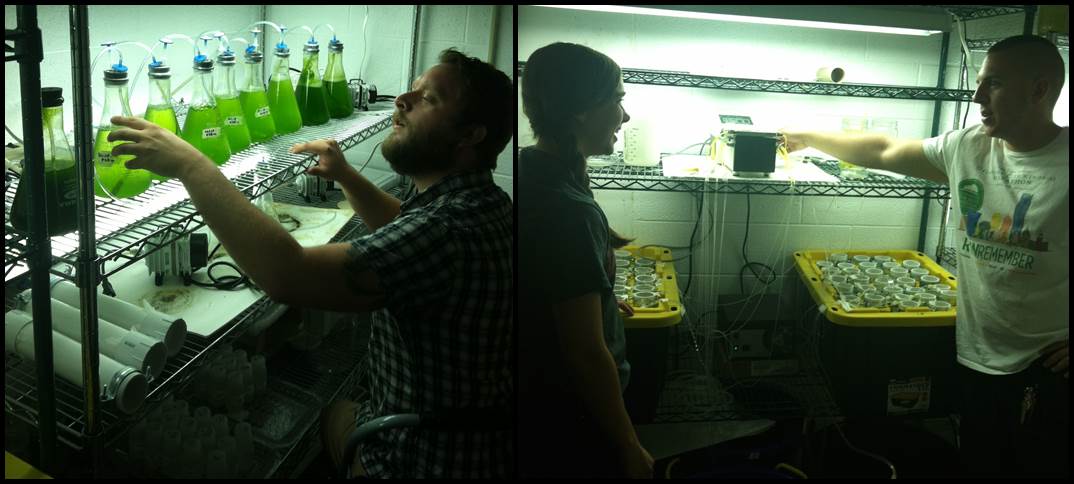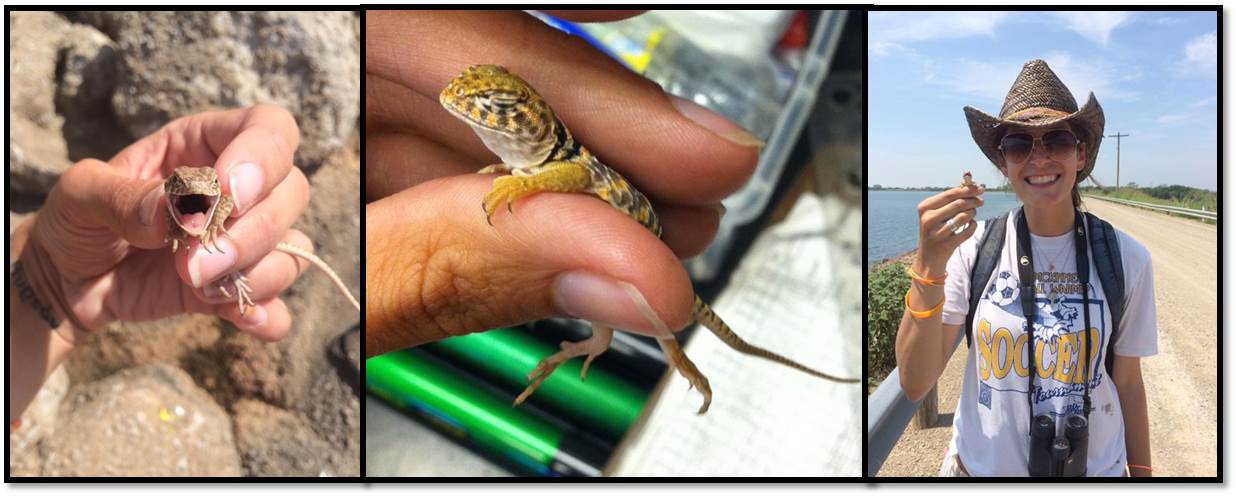 |
| Polly Campbell and collaborator Bret Pasch (Cornell) went to a site in New Mexico where three species of grasshopper mice (Onychomys) come into contact. Bret is recording vocalizations to test for evidence of reproductive character displacement and Polly is genotyping to test for evidence of hybridization. The mice they caught are enjoying all-the-crickets-you-can-eat room service at Cornell. |
 |
| This summer Medhavi Ambardar (pictured left) mentored two undergraduates (both pictured right): Anne Sabol (an undergrad from Ohio State University participating in the NSF REU program) and Erin Reynolds (an undergrad from Oklahoma State University working on independent research). Erin and Anne helped Medhavi conduct a field experiment that manipulated brood sizes of eastern bluebirds to see how brood size affects stress response of the nestlings and parental behaviors of the adults. |
 |
| Jared Goos (4th yr PhD student; pictured left) cultured Spirulina under contrasting nutrient supply conditions and fed it to Hyalella amphipods to understand the role of altered mineral nutrition in the expression and evolution of sexually selected male traits. Ryan Sherman (1st yr PhD student; pictured right) and Kristina Baker (freshman; pictured right) conducted a series of competition experiments using several clones of Daphnia pulicaria resurrected from resting eggs preserved in lake sediments. The flow-through chambers enable controlled supply of food and nutrients. These experiments will identify genotypes with highest and lowest fitness under contrasting conditions of food and nutrients that will be used for quantitative genomic studies. |
|
|
| Jessica Hoops is investigating potential reasons for the decline of the endangered American burying beetle (ABB), Nicrophorus americanus in Oklahoma. Her field work concentrates on identifying the driving factors (e.g., habitat) for ABB success in areas already known to support significant populations of the beetle. The findings from this project are helping the USFWS re-evaluate their current trapping and protocol for the beetle. |
|
|
| Sarah DuRant in collaboration with members of Bill Hopkins' laboratory (Virginia Tech) studied endocrinological patterns of nesting female Wood Ducks (Aix sponsa) in relation to clutch size and clutch thermal properties in Aiken, SC. Their research will contribute to our understanding of the evolution of clutch size in birds. A major bonus to checking Wood Duck nest boxes involves regular encounters with other native wildlife, including gators, screech owls, and mud snakes. |
|
|
| Angie Begosh, a graduate student in Dr. Loren Smith's lab, is investigating how land use affects native invertebrate pollinator diversity in the Southern High Plains of Texas. She and her technician place traps in playas and the surrounding uplands of cropland, Conservation Reserve Program (CRP) and native grasslands/rangeland so that they can compare pollinator diversity among land uses and determine how playas contribute to pollination service. An additional component of the project is to determine the plant species on which pollinators are feeding. This information will be used to populate a pollinator/plant library and construct an interactive website. This information will be used to populate a pollinator/plant library and construct an interactive website. |
|
|
| Ashley Love, a graduate student in the DuRant lab, is investigating how captivity influences immune and stress responses in house sparrows (Passer domesticus). This summer and fall she collected data to examine how time spent in captivity influences multiple measures of immunity (including wound healing, pictured above) and testing how these effects are related to changes in plasma corticosterone concentrations. This research will shed light on how immune and hormonal responses change during acclimation to captivity and highlight the importance of timing when collecting physiological measurements in wild animals brought into captive settings.
|
|
|
| Graduate student Jodie Wiggins, along with undergraduate technicians Joe Webber and Cameron Hodges, collected data on a population of Collard Lizards (Crotaphytus collaris) at Sooner Lake Dam. The aim of the study is to determine if conspicuous orange bars that appear on male hatchlings but disappear before the lizards become reproductive serve as an indicator for juvenile sexual selection. |





